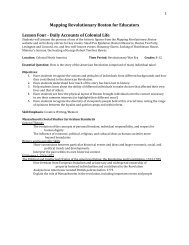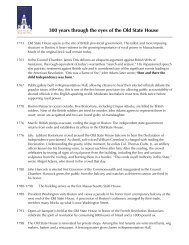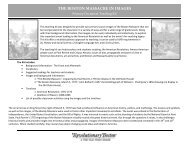Sweet History: Dorchester and the Chocolate ... - Bostonian Society
Sweet History: Dorchester and the Chocolate ... - Bostonian Society
Sweet History: Dorchester and the Chocolate ... - Bostonian Society
You also want an ePaper? Increase the reach of your titles
YUMPU automatically turns print PDFs into web optimized ePapers that Google loves.
SWEET HISTORY: <strong>Dorchester</strong> <strong>and</strong> <strong>the</strong> <strong>Chocolate</strong> Factorywww.bostonhistory.org/bakerschocolate/merchants in ports along <strong>the</strong> eastern seaboard. By 1809 <strong>the</strong> network included Philadelphia,Norfolk, Richmond, <strong>and</strong> New York. 12James Baker took leave of <strong>the</strong> business in 1804, passing all operations to Edmund, <strong>and</strong>almost immediately Edmund implemented plans to increase production. In 1806, oneyear after he took full control of <strong>the</strong> company, he bought out Samuel Leeds’s grist mills<strong>and</strong> built <strong>the</strong> first Baker’s mill outfitted for chocolate, grist, <strong>and</strong> cloth production. Thismill was operated by <strong>the</strong> first tub-wheels known to have been used in <strong>the</strong> region. Threeyears later Edmund bought Benjamin Pierce’s fulling mill in a nearby building. 13In 1807, with tight trade embargoes <strong>and</strong> an impending war, Edmund faced <strong>the</strong> sameeconomic problems his fa<strong>the</strong>r did prior to <strong>the</strong> American Revolution. During this timesmuggling cargo into American ports or through o<strong>the</strong>r routes was a way of life for manybusinessmen, <strong>and</strong> most likely Edmund was no exception. Edmund’s chocolate businesshad become quite prosperous, but <strong>the</strong> War of 1812 slowed production <strong>and</strong> businessoutside of New Engl<strong>and</strong> dried up. Surprisingly, <strong>the</strong> war did not force Edmund to shutdown chocolate production completely. He ei<strong>the</strong>r rationed his cacao stock or receivedcacao from different ports through illegal means. Whatever his methods, Edmundmanaged to keep <strong>the</strong> chocolate business operating, although alternate sources of incomebecame a necessity. 14In 1813 Edmund razed <strong>the</strong> mill he built in 1806 as well as Pierce’s old fulling mill tomake a larger, three-story granite-block mill that initially produced profitable woolens<strong>and</strong> satinet in addition to chocolate. After peace was declared in 1815, cloth productionceased in that part of <strong>the</strong> mill although later it housed an area for carding wool <strong>and</strong>spinning yarn. This additional manufacturing continued for a few more years until <strong>the</strong>family’s chocolate business regained strength <strong>and</strong> once again became a major sourceof income. 15Edmund’s twenty-six year-old son, Walter Baker, joined <strong>the</strong> family company in 1818,initially manufacturing woolen broadcloth <strong>and</strong> satinets in <strong>the</strong> Baker mill. By 1820 Waltertook on a more active roll <strong>and</strong> began recording accounts, pricing different chocolateproducts, keeping inventory, <strong>and</strong> tracking purchases. Then in 1823, at <strong>the</strong> age of fifty-three,Edmund Baker retired <strong>and</strong> h<strong>and</strong>ed over <strong>the</strong> business to Walter. 1612Edmund Baker, Account Book, 1792-1822, The Winterthur Library: Joseph Downs Collection ofManuscripts <strong>and</strong> Printed Ephemera, no. 74x333, Winterthur, DE. Merchants, ports <strong>and</strong> dates are listed variouslythrough account book beginning December 1795.13Millar, Calendar, 22; <strong>Dorchester</strong> Antiquarian <strong>and</strong> Historical <strong>Society</strong>, <strong>History</strong>, 605.14Edmund Baker, Account Book, 1792-1822. The Winterthur Library. Entries several yeas prior to <strong>and</strong>after 1812 were analyzed for production fluctuation as well as how trading changed with merchants around <strong>the</strong> region<strong>and</strong> outside of New Engl<strong>and</strong>.15<strong>Dorchester</strong> Antiquarian <strong>and</strong> Historical <strong>Society</strong>, <strong>History</strong>, 605-606.16Day Book-Jan 1814-Dec 1827, B-1, Walter Baker & Company Collection, Baker Library, HarvardBusiness School. Pages covered are sampled after 1820 which begin on page 97.7 of 76© 2005 The <strong>Bostonian</strong> <strong>Society</strong>. Nothing from <strong>the</strong> site can be reproduced without specific written permission issued by:The <strong>Bostonian</strong> <strong>Society</strong> • 206 Washington Street • Boston, MA 02109-1773. Any questions, call 617-720-1713.






